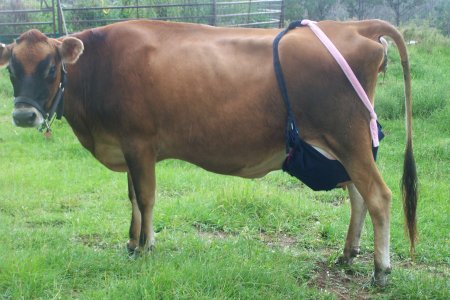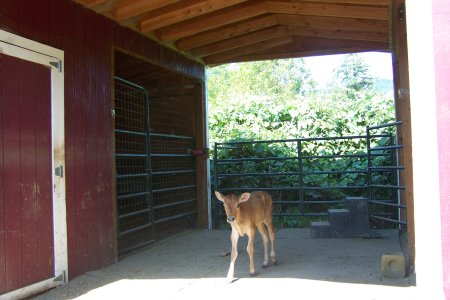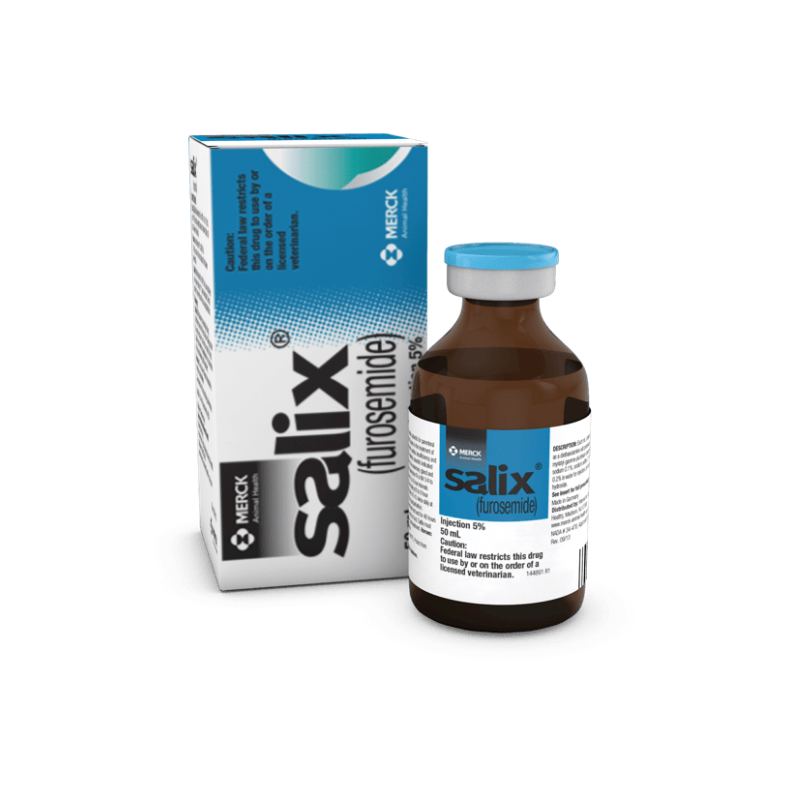TexasJerseyMilker
Well-known member
Daphne my first dairy cow and she was a calf that came from a dairy. She grew up to have little teeny milking machine teats, especially the hinds. In fact, I designed a brassier on her first lactation to try to get the calf to work the hinds and stretch them. Didn't work, still has two finger teats in the back.

I share milked, took a gallon a day from her the calf got the rest. I learned to make butter, ice cream and 7 kinds of cheese. My cholesterol levels went through the roof. Then I went to Oregon for the summer, cholesterols went down, and left my cow and calf in Texas. A fire burned onto the ranch the the cowboys evacuated all the horses and cattle, including my 2, across the river to an auction yard where they would be safe. They sold my big steer calf, it was time anyway. But they left my Jersey in full milk with open teats and the stress of weaning in a filthy auction yard dirt pen with every disease known to man with big beef cows beating her up. I came back a moth later and found my Jersey feverish nearly dead from sepsis with mastitis in all 4 quarters.
I took her to the vet. She sent samples to the lab and they all came back negative. NEGATIVE. So I found an online lab that does DNA analysis that identified 5 kinds of bacteria in her udder. Did cultures and sensitivities and found the antibiotic they were all sensitive to- Baytril. I gave her shots for 2 weeks and saved her life but she lost her back 2 quarters. Still she had enough milk to wean 7 calves. The screeby dairy character of the calves increased with each successive birth. Her first calf brought over $1000, later, not so much.
Her latest calf she hid in the pastures and apparently did not get enough colostrum. Her pretty little heifer calf died with no apparent reason at the age of about a week like a cut flower from the grocery store. I retired Daphne. Obviously she is a pet.
Now I have another Jersey dairy bottle calf, 4 months old. She is going to have those same tiny milking machine teats. I don't want to deal with mastitis from incomplete milkout and besides, my hands are getting arthritic. So, I figure I have about 2 years to find a used milking machine. I need the whole set up.
What you do is pen the calf, put a plug in one of the claws and let the machine drain the cow. Then the calf let in to drain the 4th quarter. You do this twice a day. Has anyone done this? What do you think?


I share milked, took a gallon a day from her the calf got the rest. I learned to make butter, ice cream and 7 kinds of cheese. My cholesterol levels went through the roof. Then I went to Oregon for the summer, cholesterols went down, and left my cow and calf in Texas. A fire burned onto the ranch the the cowboys evacuated all the horses and cattle, including my 2, across the river to an auction yard where they would be safe. They sold my big steer calf, it was time anyway. But they left my Jersey in full milk with open teats and the stress of weaning in a filthy auction yard dirt pen with every disease known to man with big beef cows beating her up. I came back a moth later and found my Jersey feverish nearly dead from sepsis with mastitis in all 4 quarters.
I took her to the vet. She sent samples to the lab and they all came back negative. NEGATIVE. So I found an online lab that does DNA analysis that identified 5 kinds of bacteria in her udder. Did cultures and sensitivities and found the antibiotic they were all sensitive to- Baytril. I gave her shots for 2 weeks and saved her life but she lost her back 2 quarters. Still she had enough milk to wean 7 calves. The screeby dairy character of the calves increased with each successive birth. Her first calf brought over $1000, later, not so much.
Her latest calf she hid in the pastures and apparently did not get enough colostrum. Her pretty little heifer calf died with no apparent reason at the age of about a week like a cut flower from the grocery store. I retired Daphne. Obviously she is a pet.
Now I have another Jersey dairy bottle calf, 4 months old. She is going to have those same tiny milking machine teats. I don't want to deal with mastitis from incomplete milkout and besides, my hands are getting arthritic. So, I figure I have about 2 years to find a used milking machine. I need the whole set up.
What you do is pen the calf, put a plug in one of the claws and let the machine drain the cow. Then the calf let in to drain the 4th quarter. You do this twice a day. Has anyone done this? What do you think?





